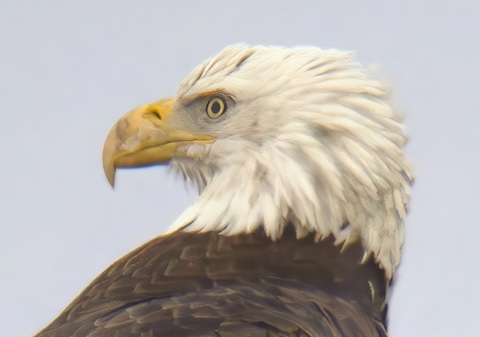As I write this column (on January 9, 2024) at a normally quiet time for wildlife in the dead of winter, the Bald Eagles in the area have already begun to prepare their nests for the upcoming nesting season! By the end of February or very beginning of March, most of the nesting pairs of Bald Eagles in our area will have laid their eggs and will be taking turns incubating them. We can look forward to a new crop of little eaglets hatching within a week either side of April 1. I know I’m looking forward to monitoring a few nests next season and following the eagle families from the egg-laying through fledging stages for the new, young eagles!

Eldamain Road bridge. Photo taken on January 8, 2024.
Three’s a Crowd!
Those of you who have followed my columns know that I have monitored the progress of a Bald Eagle family that nested along Little Rock Creek near Hinckley in our Fox River watershed last spring and summer. The adult pair raised three eaglets from tiny hatchlings through fledging into adult-sized juvenile eagles. Successfully raising three eaglets to fledge is a very unusual and difficult feat for the eagle parents. As the eaglets typically hatch about a week apart, the youngest of the eaglets is at a distinct disadvantage in terms of getting enough food to eat to survive. His/her older siblings simply are bigger and stronger and outcompete the youngest eaglet for food. Many times, the third eaglet in the brood will die of starvation or will be bullied to death by his older siblings because of the competition for food. The Hinckley nest Bald Eagle parents were incredible providers for their brood last year which enabled all three of the eaglets to survive to fledge
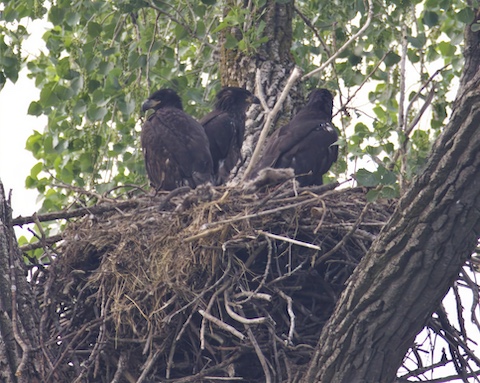
Hinckley nest last July. These three juveniles are
about adult size in this picture!
I normally don’t engage in anthropomorphizing of the birds and animals that I observe in the wild, but last year I made an exception. I named the three eaglets at the Hinckley nest Huey, Dewey, and Louie after Walt Disney’s Donald Duck’s nephews. Huey was the oldest followed by Dewey, and finally Louie brought up the rear. Watching these little eaglets feed and interact with each other and their parents in the nest and the immediate area after fledging was fascinating and brought me a lot of joy and gratification. I’m already anticipating their parents having another brood in the Hinckley nest this year!
The “Royal” Couple
In 2023 I didn’t give the adults names. This year, I’ve decided to name them due to their fantastic parenting skills displayed last year and to make it easier for me to identify them when I write about them instead of calling them mother or father eagle. So, the mother eagle will be henceforth referred to as Meghan while the father will be called Harry. I named them Meghan and Harry after the British royals that are residing in the United States. The Hinckley-Big Rock High School athletic teams are known as the Royals and I thought those names were fitting for such a regal pair of birds!
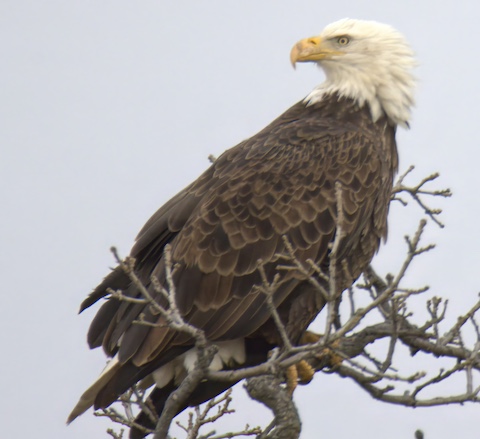
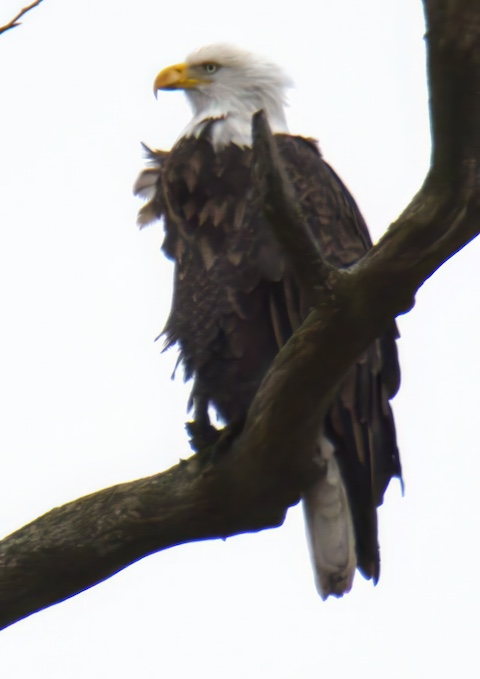
Bald Eagles, taken on January 3, 2024. He was perched in a cottonwood tree about 150 yards downstream of the nest tree.
While Bald Eagles don’t necessarily mate for life, they do display nest-site fidelity in that at least one of the mated pair almost always returns to the same nest year after year. The adult eagles test each other’s strength on an annual basis by engaging in talon-locking aerobatics, trying to determine if their partner is still strong enough to make a suitable mate and parent. I have personally witnessed one of these aerobatic displays a few years ago over the western prairie of the Hoover Forest Preserve in Yorkville, which is very close to the Eldamain Road nest that is on an island in the Fox River. The male and female eagles lock talons and spin toward the ground testing each other’s strength and mettle. If they pass muster, they will remain mates and will nest together most often in the same nest they utilized in the preceding season.
Maintaining Their “Castle”
While I haven’t seen Meghan and Harry test each other this season, they have returned to the nest site together and I have observed both of them in the nest simultaneously over the last few weeks. Harry also often stands watch in a nearby tree while Meghan arranges sticks in the nest bowl. I have seen both of them bringing sticks and grass to the nest to make updates to the nest structure in preparation for this year’s breeding. This nest construction behavior is also going on at the Big Rock (Welch Creek) and Eldamain Road (Fox River) nest sites that I observe.

in late December 2023. Both adults brought sticks,
grass, and brush to the nest to make repairs and
get it ready for the upcoming nesting season.
Bald Eagle nests are very substantial structures usually located high in very large trees close to water. At this time of year, with the leaves being off the trees, they are fairly easy to spot. If you happen to be out and about along a river, stream, or lake in our area, see if you can spot an eagle nest. If you do, look to see if any adult eagles are in or near it. If so, try to observe it (from a respectful distance: at least 100 yards) over the next few months. It could be the experience of a lifetime to watch a new year class of Bald Eagles come into being in our beautiful Fox River Valley!
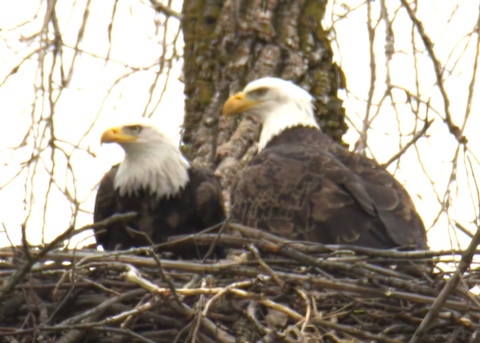
I will also be providing periodic updates over the next few months regarding the eagles’ status in this column. It’s a real treat to be able to observe these magnificent birds living and breeding in our Fox River watershed. It wasn’t all that long ago that they were almost extirpated from our area. Good stewardship of our water resources and protective legislation have resulted in a nearly miraculous comeback of our majestic national bird.
Until next time, enjoy our beautiful Fox River Valley and Keep On Fixin’ the Fox!
